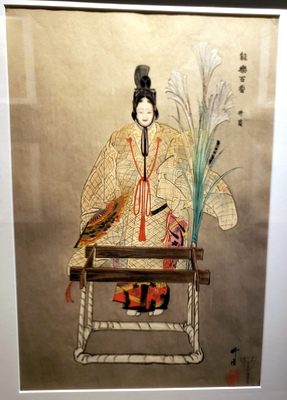Difference between revisions of "Izutsu"
From SamuraiWiki
Jump to navigationJump to search (Created page with "*''Author: Zeami'' *''Japanese'': 井筒 ''(Izutsu)'' ''Izutsu'' is a third-category Noh play, composed by Zeami Motokiyo, a particularly representative pla...") |
|||
| (2 intermediate revisions by the same user not shown) | |||
| Line 1: | Line 1: | ||
| + | [[File:Izutsu.jpg|right|thumb|400px|''Izutsu'' as depicted by [[Tsukioka Kogyo|Tsukioka Kôgyo]] in a [[Meiji period]] woodblock print]] | ||
*''Author: [[Zeami]]'' | *''Author: [[Zeami]]'' | ||
*''Japanese'': 井筒 ''(Izutsu)'' | *''Japanese'': 井筒 ''(Izutsu)'' | ||
| Line 4: | Line 5: | ||
''Izutsu'' is a third-category [[Noh]] play, composed by [[Zeami|Zeami Motokiyo]], a particularly representative play of that category (women plays). | ''Izutsu'' is a third-category [[Noh]] play, composed by [[Zeami|Zeami Motokiyo]], a particularly representative play of that category (women plays). | ||
| − | + | Based on the 23rd chapter of the ''[[Tales of Ise]]'',<ref>Ishikawa Toru, talk at Discovering the Japanese Collection at Brigham Young University Symposium, March 25, 2016.</ref> the lead (''shite'') role is that of the ghost of a lover of [[Ariwara no Narihira]], who recalls fondly playing around a well with Narihira when they were both young. In the play, she appears at the Buddhist temple housing his grave, her soul still attached to this realm and unable to rest because of her undying longing for him. | |
{{stub}} | {{stub}} | ||
| Line 10: | Line 11: | ||
==References== | ==References== | ||
*Shelley Fenno Quinn, ''Developing Zeami'', University of Hawaii Press (2005), 124. | *Shelley Fenno Quinn, ''Developing Zeami'', University of Hawaii Press (2005), 124. | ||
| + | <references/> | ||
[[Category:Poetry and Theater]] | [[Category:Poetry and Theater]] | ||
[[Category:Muromachi Period]] | [[Category:Muromachi Period]] | ||
Latest revision as of 08:41, 29 February 2020
- Author: Zeami
- Japanese: 井筒 (Izutsu)
Izutsu is a third-category Noh play, composed by Zeami Motokiyo, a particularly representative play of that category (women plays).
Based on the 23rd chapter of the Tales of Ise,[1] the lead (shite) role is that of the ghost of a lover of Ariwara no Narihira, who recalls fondly playing around a well with Narihira when they were both young. In the play, she appears at the Buddhist temple housing his grave, her soul still attached to this realm and unable to rest because of her undying longing for him.
References
- Shelley Fenno Quinn, Developing Zeami, University of Hawaii Press (2005), 124.
- ↑ Ishikawa Toru, talk at Discovering the Japanese Collection at Brigham Young University Symposium, March 25, 2016.
